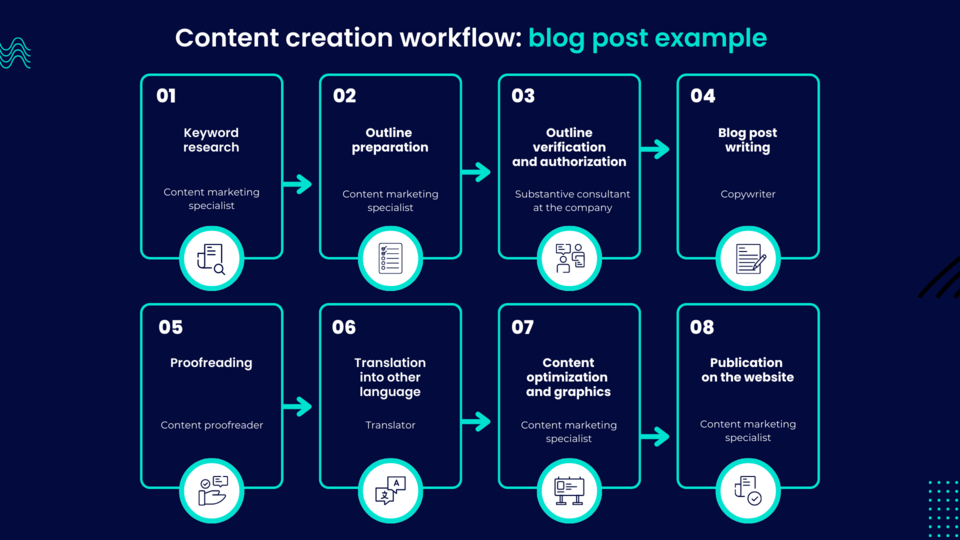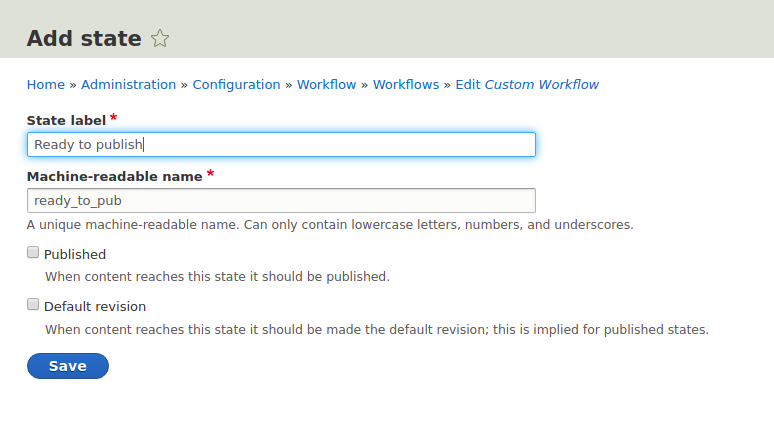
How to Build an Effective Content Creation Workflow? 5 Key Steps
Team development of company publications is a good step towards guaranteeing their high quality. However, cooperation in this field should be structured in order to catch errors faster and prevent the posting of unfinished materials on the website. To this end, it’s worth using a carefully planned content creation workflow. What is it, and how to design it?
What is workflow definition?
According to the workflow definition, it’s a process consisting of various tasks that can be assigned to individual team members and whose status can be changed as the project progresses. It helps organize the activities that a group or person undertakes by scheduling the appropriate steps for a particular type of project.
Workflow is one of the hallmarks of good CMS systems. It facilitates content production in companies and editorial offices involving more than one person in the process, thus improving the quality of publications.

Why design a content creation workflow for your business?
Developing publications in organizations is sometimes chaotic. It’s common to skip some crucial steps, such as proofreading. Putting this process in order brings many benefits, such as:
- Increased productivity when creating content – CMS systems that allow you to design your workflow make it easier to publish on time, with the option to set deadlines for completing each step and better task organization.
- Ensuring consistency of style and linguistic correctness – including detailed proofreading and style standardization in the content creation workflow makes it possible to reduce the number of errors or even eliminate them altogether.
- Better organization of work – dividing work on texts and other types of content into smaller stages makes its execution easier.
- Improving team communication – assigning employees to specific tasks is an easy way to set them responsibilities and competencies on particular projects. Changing statuses, in turn, allows team members to inform each other about progress quickly.
- Ability to verify work-in-progress – with information about who is responsible for each stage of work, leaders can more easily gain knowledge about the current skills of the people they hire. As a result, they can better plan to develop their content creation competencies.
The aforementioned advantages of using workflows can be enjoyed by those teams whose processes have been planned according to their needs and taking into account the challenges typical of specific projects.
How to perform workflow creation for the editorial team?
Workflows can be created in a CMS that has solutions such as publication statuses or assigning roles to users. Editors can rely on ready-made workflow templates or design their own processes from scratch in the content management system.
Read also: How to choose content management system (CMS)?
1. Defining the types of content to be created
Organizations that choose to design workflows should keep in mind to tailor processes to specific types of content. It’s different to create a review and another to create an interview. Various tasks need to be performed to post a photo essay on a website, and additional tasks – to prepare a webinar or other video to be shared on the web page.
The kinds of content for which workflows should be designed depend on the brand's marketing communications strategy. Newspaper editors will likely need processes for creating columns, interviews, reviews, or press releases. Business-to-business companies often need to develop various types of landing pages, blog articles, and promotional posts for social media.
Cultural institutions, on the other hand, in addition to publishing articles on their portals, must also promote the events they organize, as well as share photo and video reports. Each of these content types must be created in a specific way. The process requires the involvement of particular specialists (e.g., translators, proofreaders, film editors, graphic designers, publishers and editors) at each stage of the work.
2. Determining the necessary tasks
After indicating the forms of publications that the company will develop, it’s necessary to focus on the detailed tasks to be carried out to produce specific content. What work will go into the particular stages of a given workflow depends on the intended outcome. It's worth taking the extra time to think through the process carefully and identify the step-by-step goals that need to be achieved before publication in as much detail as possible.
Here are some sample tasks that could be steps in the process of creating the previously mentioned publication types:
- Blog post – keyword research, outline preparation (so-called brief), verification and authorization of the outline, text writing, proofreading, translation into other languages, optimizing content and adding graphics, and publication.
- Interview – gathering information about the interviewee, preparing a list of questions, conducting the interview, transcribing and processing the text, proofreading, authorization, and publication.
- Photojournalism – taking photographs, selecting photos for the album, graphic design of the material, and publication.
The tasks in a given workflow can be quite numerous. To ensure quality content, they should be performed in a thoughtful order.
3. Making the content creation process more orderly
People responsible for designing the workflow for a particular type of content should consider which tasks they need to do first and which last. In some cases, the various activities must follow one another accordingly. For example, text translation should be done only after corrections, and an interview mustn’t be published before the content is authorized.
You can structure work by assigning employee data to tasks when their expertise is needed and changing the status of publications on an ongoing basis as they progress. Companies have simple and more complicated processes. Uncomplicated workflows usually require only two statuses: Draft and Published.
When creating content that requires authorization from a responsible person inside the organization, a company partner, or an interviewee, it’s essential to be able to generate a preview of the unpublished material.
4. Assigning roles to employees
When defining the tasks and the order in which they’re to be performed, it’s also worth considering which people will be necessary in the creative process and what their responsibilities are to be in the project. It’s advisable to have employees with the right qualifications to perform specific tasks in the workflow. You can distinguish between specialists in writing texts, proofreading, creating graphics, recording videos, or commenting on substantive aspects.
You can link staff roles to individual statuses in the workflow. In this way, when the author finishes creating the original version of the text and sends it for substantive evaluation, the person authorized to comment will immediately receive a notification. In addition, confusion can be prevented by excluding unauthorized people from taking action at certain stages.
5. Workflow management
The right to assign statuses and deadlines to tasks can be reserved for the website administrator or editorial team leader. This will give them more control over ongoing processes. Such a person should also be able to restore deleted publication statuses to protect the team from unwanted losses due to mistakes.
An essential task in controlling the workflow is managing roles, that is, granting and revoking permissions. The creation of publications may require the participation of third parties, in which case it’s helpful to generate a preview of the text and make it available to others with the guarantee that they cannot modify it.
A token can be generated from content with draft status, which allows people without a CMS account to see the material. The token only enables you to preview. It’s used to show content to partners for authorization before publication.
Tools for developing content workflows
There are several CMS systems where it’s possible to design a workflow for a team. Such editing tools can be customized with available plugins and modules.
One such content management system is Drupal, which allows users to set the status of a task (concerning the creation of an article, for example) to unpublished and published. The former makes the text saved in the CMS visible only to those who work on it and have the appropriate access. Changing to the second status allows the content to be available to anonymous website users.
You can extend these basic capabilities provided by Drupal by using additional modules such as workflows and content moderation. With these, intermediate statuses can be added to the workflow, such as: Draft, To moderate, To check, To approve, or Ready to publish.

Configuring new content status in the Workflows module for Drupal
The content moderation module allows you to assign roles to users, and thus – to set them content editing rights selected by the administrator. In this way, you can designate people responsible for content creation, moderation, and approval of finished publications.
Another helpful solution is the Content Locking module. A user who encounters content under such a lock will see all functionalities of the CMS, but won’t be able to edit the publication. Those with sufficiently high privileges can break the lock manually and modify the entry. This can also be done using the content lock timeout submodule. It’s used to unblock a post after a certain time set by the person imposing the lock has passed.
Content production workflow – summary
At Droptica, we’ve already designed many workflows that make it easier for companies to create content. An example is the solutions used in the CMS customized for the editors of the Zawsze Pomorze website. What sets it apart is the simplicity of the process. It allows the creation and modification of a draft version, its approval by authorized users, and publication scheduling on a specific day. The tool enables editors to create content without major restrictions.
Do you need a similar solution? We can create a custom CMS for you, which we’ll equip with a content workflow tailored to the tasks at hand and your team's work style.













